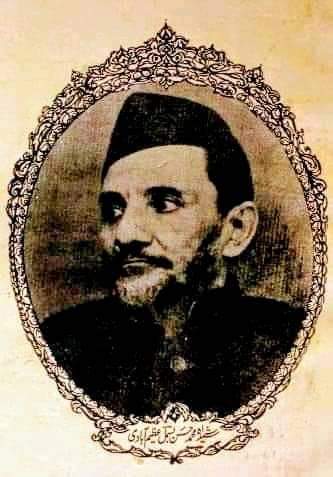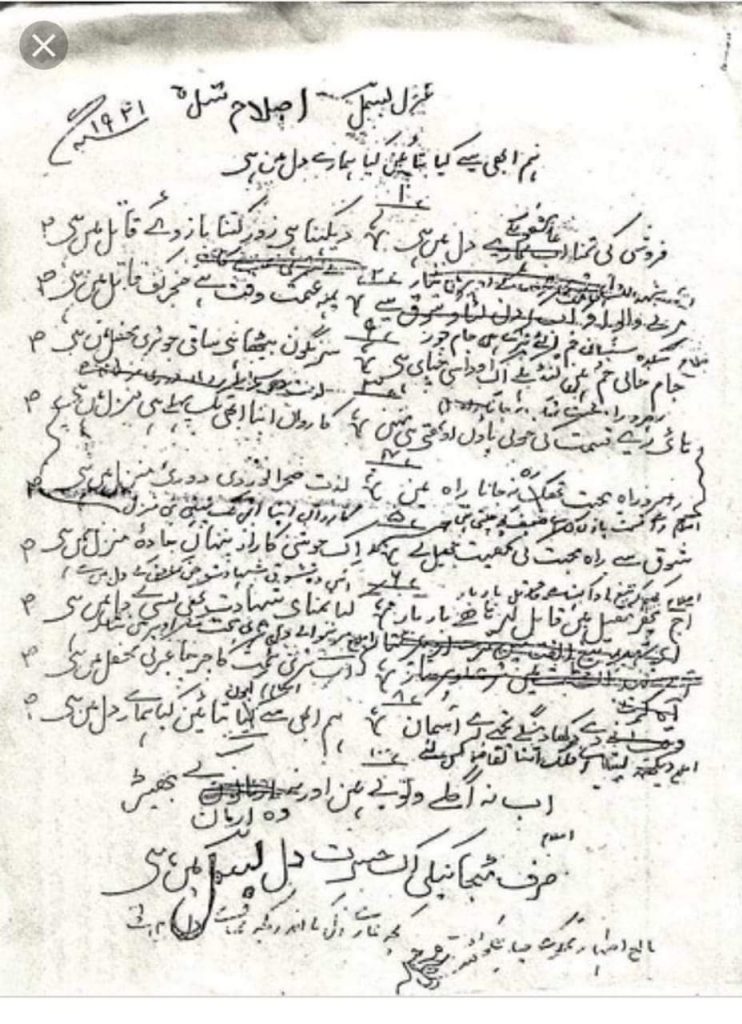
Urdu as a language is deeply entrenched with the composite heritage of India that has given us slogans and songs such as Inquilab Zindabad , Sarforoshi Ki Tamanna Ab Hamare Dil mein Hal, Sare Jahan se Achcha Hindostan hamara to name a few. I have picked up a song “Sarafroshi ki tamanna” for our short review title. This is one of those songs that has achieved an immortal fame in the history of Indian freedom movement and could arguably be the most famous patriotic poems of all time in India.
Sarfaroshi ki tamanna ab hamaare dil mein hai
Dekhna hai zor kitna baazu-e-qaatil mein hai
(In our hearts is now the desire for sacrifice – Let’s see how much strength is in the arms of killer)
This couplet is actually the first sher of a long ghazal (poem) composed in ornamental Urdu , these lines highlight the willingness of courageous but disciplined freedom fighters to sacrifice their life for their motherland while awaiting the worst action from the opponent.
It became a war cry during the freedom struggle when the firebrand protagonist of freedom Pandit Ram Prasad Bismil (1887-1927) of Shahjahanpur popularized the poem in such a powerful way that the couplet became an icon of the Jang-i-Azadi. It was immortalized in the chronicles of Indian freedom struggle. However the original writer of these lines was for a long time remained unknown.
Ram Prasad Bismil (1897-1927)
The person who made this poem/sher popular among the masses was Pandit Ram Prasad Bismil, a notable revolutionary who struggled against the British regime in India. His name was figured in Mainpuri conspiracy case of 1918 and the Kakori conspiracy of 1925. The trial in the Kakori conspiracy case sentenced him and three other revolutionaries namely Ashfaqullah Khan, Roshan Singh and Rajendra Nath Lahiri to be hanged till death. While lodged in jail, he penned his autobiography ‘Kakori Ke Shaheed’
He was an avid reader and fan of Urdu poetry and added a pseudonym “Bismil” with his name. He was known to employ Urdu poetry profusely as his weapon to mobilize the youths for non-co-operation with the Government. The impact of his selection of poetry was enormous and the chord of hearts vibrated with hostility against the Raj.
It is reliably reported that this couplet “Sarfaroshi ki tamanna” was on his lips on 19 December, 1927 when he walked to the gallows in Gorakhpur Jail, and from here couplet got so much fame that it became immortal with his name forever. Later on the poem was used in different forms of media with Ram Prasad Bismil’s name that the name of original composer was entirely forgotten and got shrouded in mystery.
Sarfaroshi ki Tamanna ab hamare dil me hai
Actually these lines are the first sher of a long poem (ghazal) penned by Bismil Azimabadi, a young nationalist poet from Azimabad (Patna). He composed this poem in 1920 which got published in 1921 in an Urdu Daily from Delhi named “Sabah” edited by Qazi Abdul Ghaffar. Qazi Abdul Ghaffar was a nationalist writer and editor of “Ukhuwat” Lucknow but due to his anti establishment editorials, the paper fell victim to the repressive press laws of British India. He was forced to leave Lucknow & he moved to Delhi where he started another journal, Sabah, under the patronage of Hakim Ajmal Khan, the leader of the Khilafat Movement. This original poem was published in one of its edition in 1921. The British again found this poem offensive and the editor was given a warning and the edition got seized. Now the question arises, when the poem was already published in a daily and was taken into notice by the government, how come the poet got obscure and unknown for so many years ?
Here was shall dwell upon the reasons.
Reason for the confusion
1. The first reason that helped the poem getting attributed to Pandit Ram Prasad Bismil was that he wrote articles, pamphlets and was reported to be a poet. This image of being a poet was taken without doing any search or research. Undoubtedly, Ram Prasad Bismil was an avid fan of Urdu Poetry. He quoted and used relevant Urdu poetry as a tool to make the common man wake up and fight against the British rule. It is noteworthy that he liked the verses more where his nom de plume was used. In his autobiography “Atma Katha” we find a number of Urdu verses with the word Bismil after a minor changes in few words. However for me, it is a matter of further research whether he really composed anything of his own in Urdu? I have not found any original poem or verse composed by him anywhere. Though some of his works in prose are certainly found.
2. The second important factor was the pen name – both the composer and the singer had the same nom de plume. The original poet Bismil Azimabadi and the person who immortalized it Ram Prasad Bismil both had the same pseudonym; and this created a huge confusion. Most of the people believed that it as Pt Ram Prasad’s own creation because he has used Bismil in this last line.
3. Third important point that has not been studied altogether and what could be the main reason for the confusion and the resultant wild guess about the poem was the fact that Bismil Azimabadi himself avoided to acknowledge the poem as his own creation because of the fear of backlash from the British after the newspaper was seized where it got published. Janab Abu Muhammad Shibli took an interview from Bismil Azimabadi wherein he told him that the poem was published in Qazi Abdul Ghaffar’s journal Sabah in 1921. The British Government had already been keeping an eye on him, they rebuked the editor and seized that edition. Qazi Abdul Ghaffar wrote to Bismil that I have been taken to task by the government, you might also be grilled and advised him to be cautious. Upon this Bismil approached his mentor Shad Azimabadi who was a Khan Bahadur (title holder) and he edited the poem in the way that it lost its revolutionary appeal. He further told that he openly declared this piece to be his poem in 1957 when he wrote his autobiography named “ Yaaran e Maikadah”. By that time , the entire country has almost accepted the poem to be penned by Ram Prasad Bismil.

Bismil Azimabadi (1901 – 1978)
Now let’s have a look at the life of the poet Bismil. The word Bismil means hurt or wounded , here is a sher to this effect by Bismil

Hum to bismil hi rahe khair hui
Ishq me _____jaan chali jaati hai
Bismil Azimabadi’s real name was Syed Shah Muhammad Hasan who was a descendant of Makhdoom Syed Shah Fareed-ud-Din Tawela Bakhsh Chishti of Chand Purah Bihar.(d.897 Hijri/1492G). His belonged to the landed gentry and the family was initially based at Khusropur Newada but lived mostly in a village Hardas Bigaha and finally settled at Lodhi Katra, Patna City. From maternal side he descended from Makhdoom Syed Habeebullah Mashhadi of Kaku, District Gaya. This family was also settled at Patna. His maternal Grandfather Shah Mubarak Kakvi Azimabadi and his maternal Uncle, Khan Bahadur Syed Shah Muhiuddin alias Shah Kamal both were poets. Both of them were disciple of famous ustad poet of Allahabad Janab Waheed Allahabadi.

Bismil’s father Syed Shah Aal-i-Hasn was a Barrister (Bar-at-Law) and died at an early age when Bismil was a toddler. Bismil shuttled between his place and his maternal home at Patna. The atmosphere of Azimabad was poetic and literary. It was from there he picked up the love for Urdu poetry. This was a period when it was normal to find one or two poets in every educated clan in Patna. Syed Muhammad Hasan chose the word Bismil (meaning hurt or wounded) as his pen name and became disciple of Shad Azimabadi, (1846-1929),the legendary Urdu Poet from Bihar. During the same time , Bismil joined the freedom movement and developed the nationalist views. He even attended the Congress Session at Calcutta in 1920 where he recited this poem. Afterwards the same ghazal got published in Sabah Delhi and from where it gained national fame. Khuda Bakhsh Library has preserved the original copy and page of his diary where this poem is written and the corrections done by his mentor Shad Azimabadi can be seen very clearly. This is an indisputable evidence that the ghazal was penned by Bismil Azimabadi.

Coutesy – Khuda Bakhsh Library
A lot of scholars, were misled by the popularity and its association with Ram Prasad Bismil that they could not arrive to the fact and could never reach the author. This made Bismil somewhat upset and he felt dismayed when he could not get the credit of his poem even after the independence . This is recorded in the memoirs of Wamiq Jaunpuri “Guftani Na Guftani” where Bismil rued that sometimes we see that a lost belonging comes back to the owner but my ghazal did never come back to me.
Bismil died on 20 June 1978 and was survived by five sons and three daughters. His sons was Syed Shah Ahmad Hasan, Hamid Hasan, Mehdi Hasan, Hadi Hasan and Jamal Hasan. Most of his Kalam was lost and the remaining was compiled and published by the name of Hikayat-i-Hasti in 1980 with the help of Khuda Bakhsh library. He wrote a short personal memoir named Yaraan-i-Maikadah in 1976.
Here I would quote some of his Ash’aar so that the readers have an idea of the great poet !
Meri Nigaah Kaam na de aur baat hai
Jalwa Tera Baqadr-i-zaroorat Kahan Nahin !
Deorhi pe ek faqeer bhi hai, ahl-i-zar ke baad
Saaqi idhar bhi ik piyala , udhar ke baad
Shukr kar shukr jo saaqi kam de
Us ka har fe’l hakeemana hai !
Qadam qadam pe hai saamna qayamat ka
Zamana phir bhi qayamat ke intezaar me hai
References:
- Manzar, Habib (2004). “Revisiting Kakori Case on the basis of Vernacular Reportage”. In Sinha, Atul Kumar (ed.). Perspectives in Indian History.
- Ata Kakwi (1978), Sarfaroshi ki Tamanana – AajKal , New Delhi.
- Bismil Azeemabadi (2008), Muhammad Iqbal, Educational Publishing House Delhi.
- Abu Muhammad Shibli : Kya Ram Prasad Bismil Shair they ?
- Hikayat I Hasti (1980), Syed shah Mehdi hasan & Syed Hadi Hasan.
Khalid Bin Umar is a history buff who writes on Micro-history, Heritage, Sufism & Biographical accounts. His stories and articles has been published in many leading magazines. Well versed in English, Hindi, Urdu & Persian, his reading list covers a vast arrays of titles in Tasawwuf & Oriental history. He is also documenting lesser known Sufi saints of India



